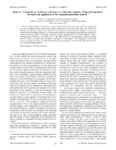
Please use this identifier to cite or link to this item:
http://ricaxcan.uaz.edu.mx/jspui/handle/20.500.11845/554Full metadata record
| DC Field | Value | Language |
|---|---|---|
| dc.contributor.other | https://orcid.org/0000-0001-5324-1834 | es_ES |
| dc.coverage.spatial | global | es_ES |
| dc.creator | Chubykalo, Andrew | - |
| dc.creator | Smirnov Rueda, Roman | - |
| dc.date.accessioned | 2018-06-14T18:14:38Z | - |
| dc.date.available | 2018-06-14T18:14:38Z | - |
| dc.date.issued | 1998-03 | - |
| dc.identifier | info:eu-repo/semantics/publishedVersion | es_ES |
| dc.identifier.issn | 2470-0053 | es_ES |
| dc.identifier.issn | 2470-0045 | es_ES |
| dc.identifier.uri | http://hdl.handle.net/20.500.11845/554 | - |
| dc.identifier.uri | https://doi.org/10.48779/h3rk-mq61 | es_ES |
| dc.description.abstract | The preceding Comment criticized the necessity of introducing an electrodynamics dualism concept based on a novel complete solution of Maxwell’s equations proposed in our previous paper @Phys. Rev. E 53, 5373 ~1996!#. All arguments made by the authors of the Comment to demonstrate the adequacy of the usual Lie´nard-Wiechert retarded solutions for a consistent description of electromagnetic phenomena are shown to be invalid beyond the context of boundary conditions for the inhomogeneous D’Alembert equation. From a reinterpretation of Villecco’s work @Phys. Rev. E 48, 4008 ~1993!# we concluded that it cannot be applied directly to refute our results and, in contrast to the opinion of the authors of the Comment, it can be used instead to support our claims of mathematical deficiency and inadequacy of Lie´nard-Wiechert retarded solutions. @S1063-651X~98!12402-9# | es_ES |
| dc.language.iso | eng | es_ES |
| dc.publisher | American Physical Society | es_ES |
| dc.relation | https://journals.aps.org/pre/abstract/10.1103/PhysRevE.57.3683 | es_ES |
| dc.relation.uri | generalPublic | es_ES |
| dc.rights | Atribución-NoComercial-CompartirIgual 3.0 Estados Unidos de América | * |
| dc.rights.uri | http://creativecommons.org/licenses/by-nc-sa/3.0/us/ | * |
| dc.source | PHYSICAL REVIEW E Vol. 57, No. 3, p. 3683-3686 | es_ES |
| dc.subject.classification | CIENCIAS FISICO MATEMATICAS Y CIENCIAS DE LA TIERRA [1] | es_ES |
| dc.subject.other | separated-potentials method | es_ES |
| dc.subject.other | Maxwell equations | es_ES |
| dc.title | Reply to ‘‘Comment on ‘Action at a distance as a full-value solution of Maxwell equations: The basis and application of the separated-potentials method’ ’’ | es_ES |
| dc.type | info:eu-repo/semantics/article | es_ES |
| Appears in Collections: | *Documentos Académicos*-- UA Física | |
Files in This Item:
| File | Description | Size | Format | |
|---|---|---|---|---|
| 1998-PRE_1998.pdf | 81 kB | Adobe PDF |  View/Open |
This item is licensed under a Creative Commons License
